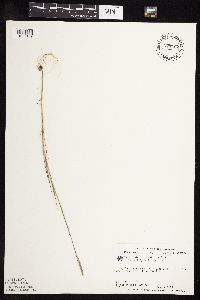Muhlenbergia glomerata
|
|
|
|
Family: Poaceae
Spiked Muhly, more...Spike Muhly (fr: Muhlenbergie Agglomérée)
[Agrostis festucoides Muhl. ex Roem. & Schult., moreAlopecurus glomeratus (Willd.) Poir., Muhlenbergia calycina (Trin.) Trin., Muhlenbergia glomerata var. cinnoides (Link) F.J.Herm., Muhlenbergia glomerata var. glomerata (Willd.) Trin., Muhlenbergia racemosa subsp. violacea Scribn., Muhlenbergia racemosa var. cinnoides (Link) B.Boivin, Muhlenbergia setosa var. cinnoides (Link) Fernald, Polypogon glomeratus Willd., Polypogon setosus Biehler] |
Plants perennial; rhizomatous, not cespitose. Culms 30-120 cm tall, 0.8-2.5 mm thick, erect, seldom branched above the base; internodes dull, mostly puberulent (sometimes sparsely so), terete, rarely keeled, strigose immediately below the nodes. Sheaths scabridulous, slightly keeled; ligules 0.2-0.6 mm, membranous, truncate, lacerate-ciliolate; blades 2-15 cm long, 2-6 mm wide, flat, usually scabrous or scabridulous, occasionally smooth. Panicles 1.5-12 cm long, 0.3-1.8 cm wide, lobed, dense; primary branches 0.2-2.5 cm, appressed; pedicels absent or to 1 mm, strigose. Spikelets 3-8 mm. Glumes subequal, 3-8 mm (including the awn), about 1.3-2 times longer than the lemmas, smooth or scabridulous distally, 1-veined, acuminate, awned, awns to 5 mm; lemmas 1.9-3.1 mm, lanceolate, pubescent on the calluses, midveins, and margins, hairs to 1.2 mm, apices scabridulous, acuminate, unawned or awned, awns to 1 mm; paleas 1.9-3.1 mm, lanceolate, loosely pilose between the veins, apices acuminate; anthers 0.8-1.5 mm, yellowish. Caryopses 1-1.6 mm, fusiform, brown. 2n = 20. Muhlenbergia glomerata grows in meadows, marshes, bogs, alkaline fens, lake margins, stream banks, beside irrigation ditches and hot springs, and on gravelly slopes, in many different plant communities, at elevations of 30-2300 m. It is most common in southern Canada and the northeastern United States, but grows sporadically throughout the western United States. It is not known from Mexico. Perennial rhizome-forming herb 30 cm - 1.32 m tall Leaves: with open, minutely rough, slightly longitudinally ridged sheaths and ligules that are 0.2 - 0.6 mm long, membranous, flat-topped and unevenly cut to hairy along the margins. The blades are 2 - 15 cm long, 2 - 6 mm wide, flat, usually rough but sometimes smooth. Inflorescence: terminal, spike-like and branched (panicle), dense, 1.5 - 12 cm long, 0.3 - 1.8 cm wide, with appressed primary branches that are 0.2 - 2.5 cm long. Fruit: a brown, spindle-shaped caryopsis, 1 - 1.6 mm long. Culm: 30 cm - 1.2 m long, erect, rarely branching above the base, 0.8 - 2.5 mm wide, circular in cross section, rarely longitudinally ridged, the internodes appressed hairy just below the nodes but dull and minutely hairy elsewhere. Spikelets: 3 - 8 mm long, stalkless or borne on a stalk to 1 mm long. Glumes: nearly equal, 3 - 8 mm long, single-veined, with a smooth or minutely rough pointed tip and an awn to 5 mm long. Florets: with yellowish anthers 0.8 - 1.5 mm long. Lemma: 1.9 - 3.1 mm long, lance-shaped with minutely rough pointed tips, sometimes with an awn to 1 mm long, three-veined, with hairs to 1.2 mm long on the midveins and margins. Palea: 1.9 - 3.1 mm long, lance-shaped with a pointed tip, two-veined, loosely soft-haired between the veins. Similar species: The following species also have culms that are dull and minutely rough to hairy beneath the nodes. Muhlenbergia tenuiflora is easy to distinguish because its leaf blades are wide (to 15 mm), the often terminal inflorescence is 10 - 33 cm long, and the glumes are shorter than the lemmas. Muhlenbergia sylvatica and Muhlenbergia mexicana have both terminal and axillary inflorescences to 21 cm long and glumes that are shorter than or equal to the lemmas. Flowering: late July to early September Habitat and ecology: Locally frequent in prairie fens. Occurence in the Chicago region: native Etymology: Muhlenbergia is named after American botanist, Gotthilf Henry Ernest Muhlenberg (1753-1815). Glomerata means "in clustered heads." Author: The Morton Arboretum Vigorously rhizomatous, 3-12 dm, stiffly erect, unbranched or sparingly branched; internodes finely puberulent, especially near the top; blades and sheaths glabrous, the blades 6-15 cm נ2-6 mm; ligule 0.2-0.6 mm, somewhat ciliate; infl a dense, cylindric, somewhat lobed panicle 2-11 cm נ3-15 mm, on a peduncle 5-15 cm; spikelets green to often purplish, densely crowded, 3.2-5(-8) mm, the glumes subequal, much exceeding the lemma, tapering to a rigid awn nearly as long as the body; lemma 2-3.5 mm, awnless or rarely with a minute awn-tip, bearded on the callus and pubescent along the veins and margins, sometimes nearly to the tip; anthers 0.8-1.5 mm; grain 1-1.6 mm; 2n=20. Marshes, gravelly shores, wet meadows, seepage areas, and bogs; Nf. to B.C., s. to N.C., Ky., Io., Nebr., Utah, and Nev. Gleason, Henry A. & Cronquist, Arthur J. 1991. Manual of vascular plants of northeastern United States and adjacent Canada. lxxv + 910 pp. ©The New York Botanical Garden. All rights reserved. Used by permission. From Flora of Indiana (1940) by Charles C. Deam Indiana Coefficient of Conservatism: C = 10 Wetland Indicator Status: FACW |






















































































